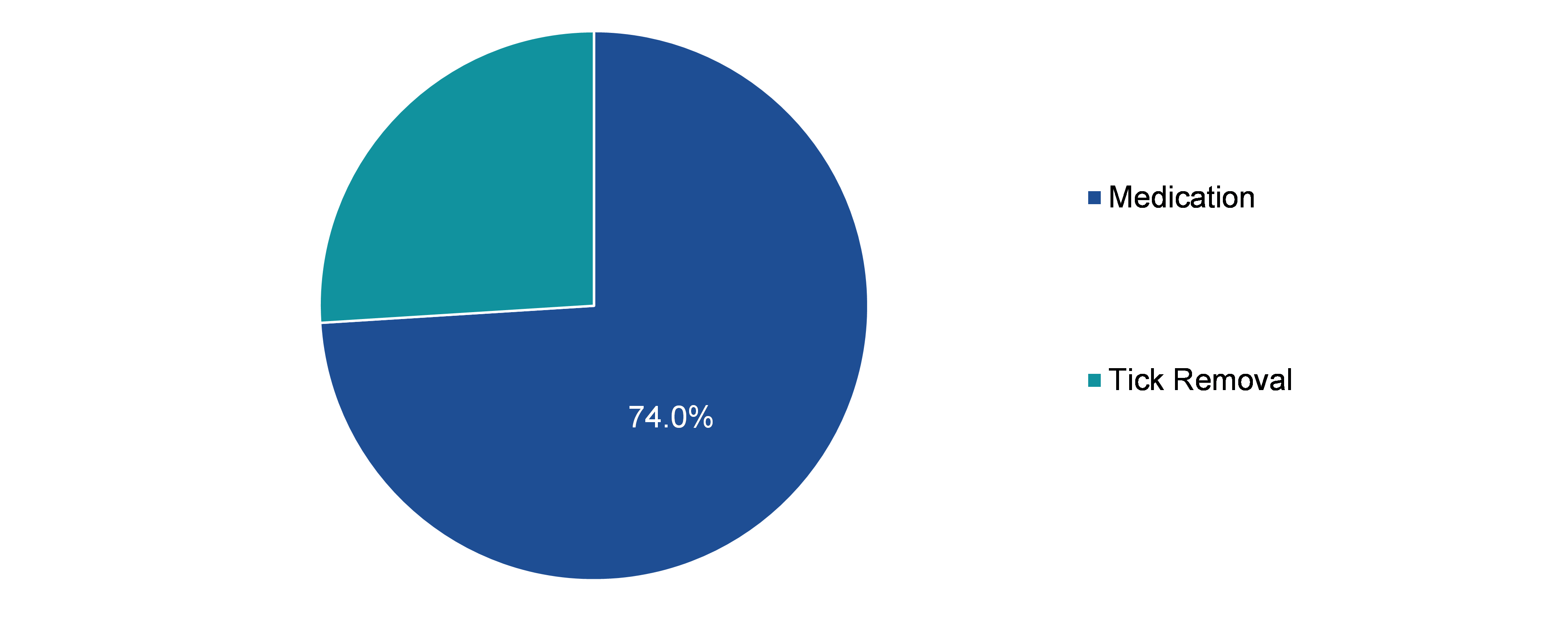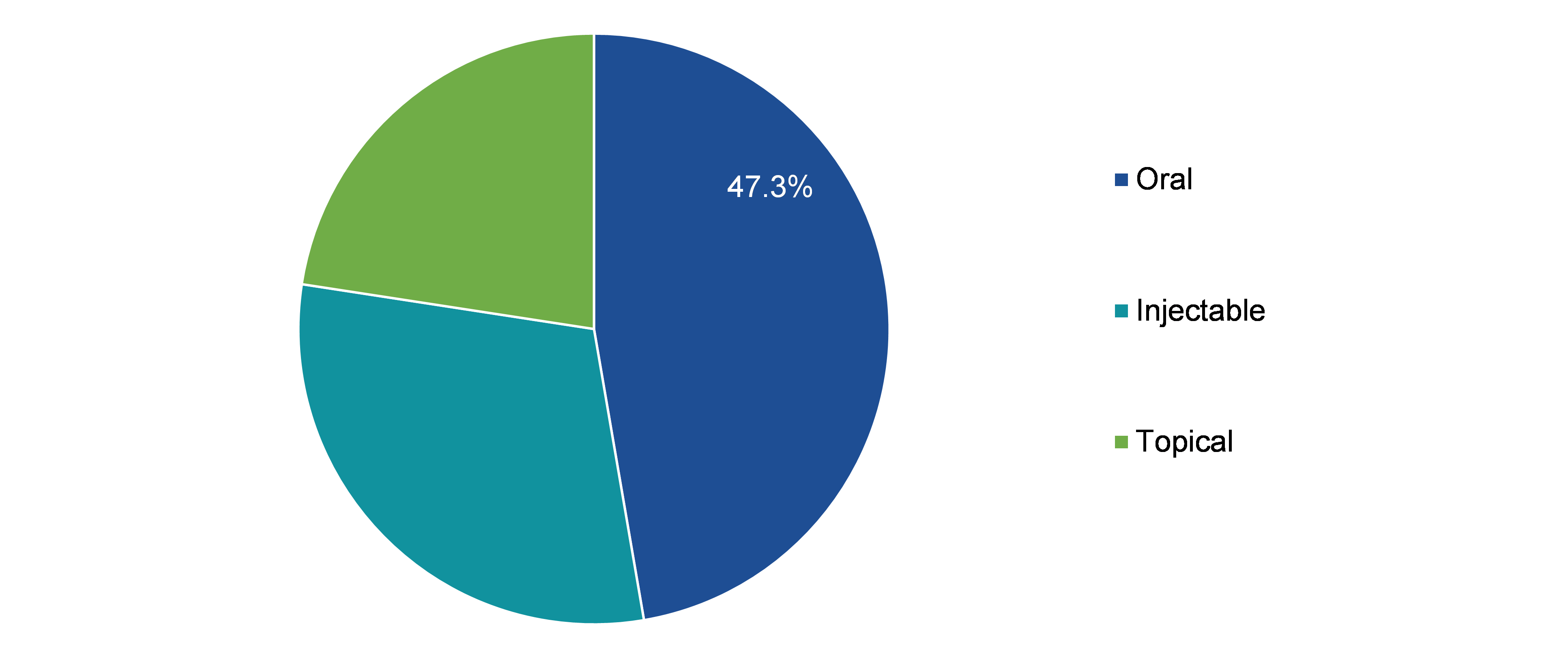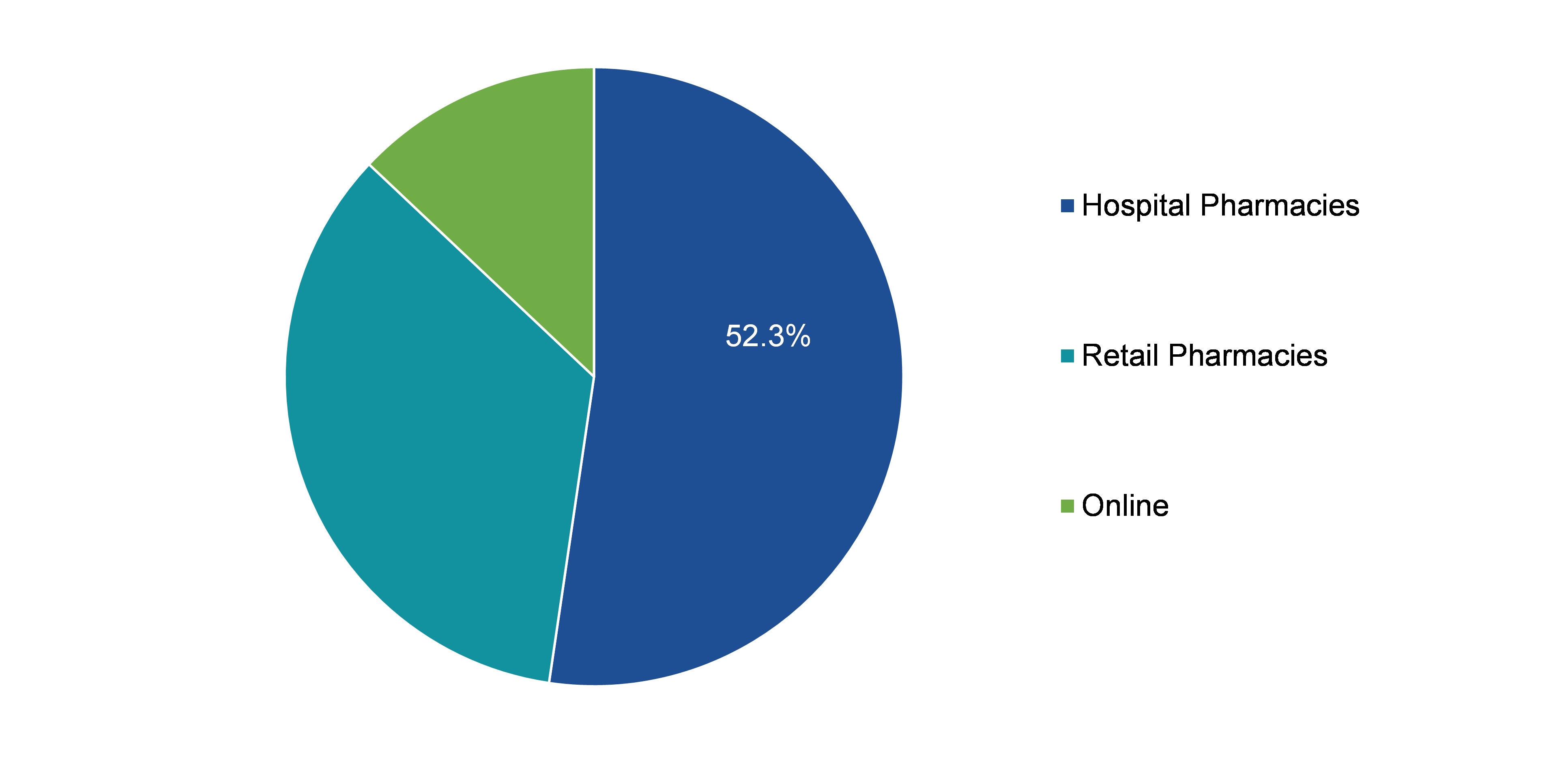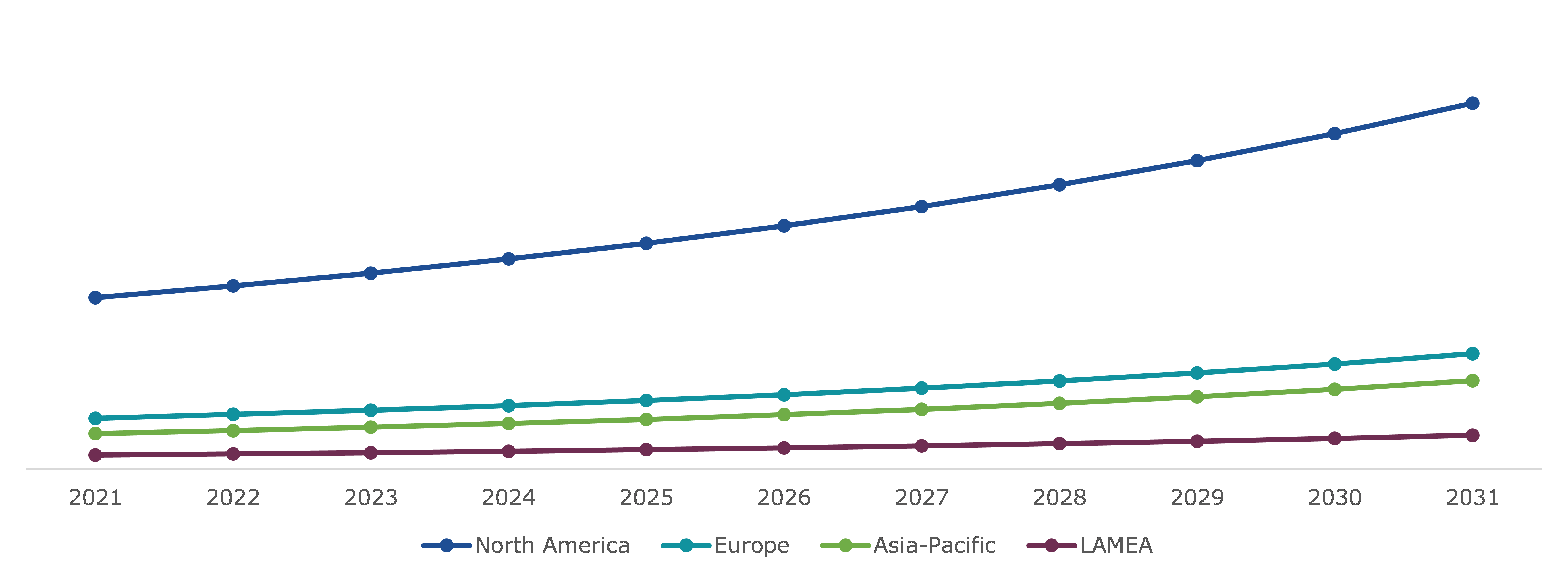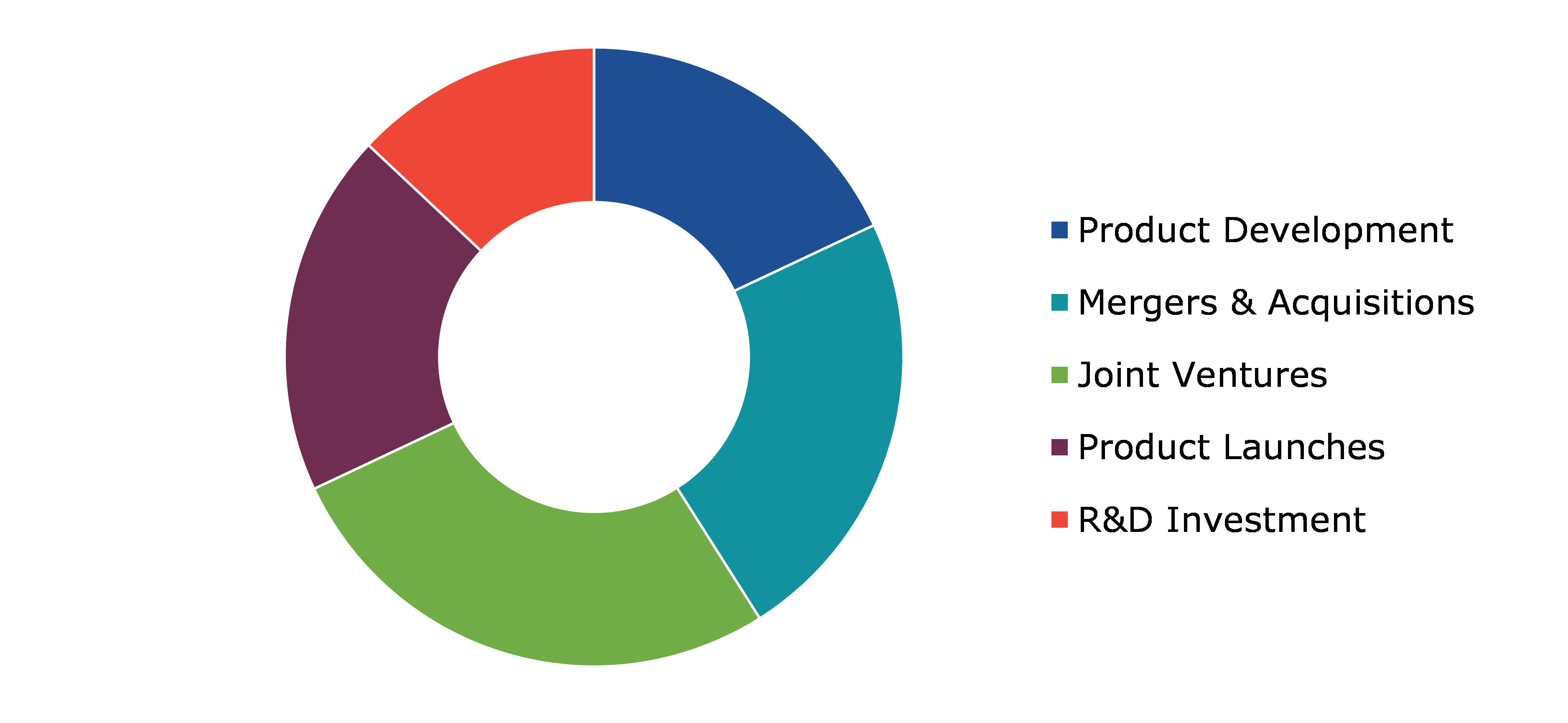Lyme Disease Treatment Market Report
RA08501
Lyme Disease Treatment Market by Treatment Type (Medication and Tick Removal), Administration Route (Oral, Injectable, and Topical), Distribution Channel (Hospital Pharmacies, Retail Pharmacies, and Online), and Regional Analysis (North America, Europe, Asia-Pacific, and LAMEA): Global Opportunity Analysis and Industry Forecast, 2022-2031
Global Lyme Disease Treatment Market
The global Lyme disease treatment market size was $737.5 million in 2021 and is predicted to grow with a CAGR of 8.4% by generating a revenue of $1,636.6 million by 2031.
Global Lyme Disease Treatment Market Synopsis
Lyme illness Borrelia are obligatory parasitic, invasive, persistent, tick-transmitted, bacterial infections that predominantly cause inflammation to cause disease in humans and non-reservoir animals. During the germs are transmitted by the infected tick substantial alterations in gene expression that adaptability to the environment found in mammals. The organisms proliferate, spread widely, and cause humans experience inflammatory reactions that lead to clinical symptoms and indications. The rash is generally neither itchy nor painful. Other early signs and symptoms can also additionally encompass fever, flu like symptoms, joint pain in limbs and tiredness. If untreated, signs and symptoms can also additionally encompass lack of the capacity to transport one or each facets of the face, joint pains, and extreme complications with neck stiffness or coronary heart palpitations. Based on symptoms, cefuroxime, doxycycline, or amoxicillin are typically used to treat Lyme disease in adults and children. Despite being an effective treatment, 10 to 20%of those affected continue to experience joint pain, memory issues, and fatigue for at least six months. Increase in the number of cases of Lyme disease and extensive possibility for growth of antibiotics for curing patients are having disease are the factors expected to drive the global Lyme disease treatment market growth over the forecast period. For instance, International Lyme and Associated Disease Society (ILADS) recommends customized antibiotic treatment for the patients depending on their response to treatment, as Lyme disease is hard to diagnose which results into persistent infection. However, the treatment of antibiotics cannot reduce the infection of Lyme disease, which in turn gives a wider scope for development of ideal antibiotic treatment of Lyme disease.
If Lyme disease remains untreated, it can spread to other parts of body for many more months to years after infection, triggering arthritis when bacteria of Lyme disease enters into tissue of joints and cause hypersensitivity reaction and neurological problems such as unresponsiveness, discomfort, weakness, and facial palsy/ (facial muscle paralysis). Nerves can also transmit other illnesses, such as Babesiosis is produced by parasites that pollute red blood cells and Colorado tick fever. Colorado Tick Fever (CTF) is unusual type of viral disease by the chewing of a diseased Rocky Mountain wood tick which is generally originated in the western part of Canada and the U.S. There are no any medicines and vaccines to prevent infection of CTF. So, it is anticipated that it hampers the growth of the market in forecast period.
Innovations are ongoing in the medicinal industry in the area of immunization. This is anticipated to increase the frequency of prevention of Lyme disease in the upcoming days. The development of a vaccine to protect individuals from infected ticks is a continuing goal of medical experts and researchers as the number of Lyme disease cases increases globally. For instance, doctors from the UMASS Medical School in the U.S. have reportedly been working on producing a medicine, PrEP (pre-exposure prophylaxis) for Lyme cure. The medication has the ability to give patients antibodies against Lyme disease. Phase 1 clinical studies for this Lyme treatment are now taking place, and a market launch is anticipated for 2023. For instance, in April 2020, Valneva and Pfizer entered into a partnership to develop VAL15 multivalent protein vaccine.
According to the regional analysis of the market, the Asia-Pacific Lyme disease treatment market analysis accounted for $96.1 million in 2021 and is projected to grow with a CAGR of 9.7% in the projected timeframe. This is due to increasing cases of tick borne disease in this region and its prevalence rate increasing day by day.
Lyme Disease Treatment Overview
Lyme disease is spread by the bacteria Borrelia burgdorferi and hardly, Borrelia mayonii. It is transferred to human being through the chewing of infected blacklegged ticks. Typical sign and symptoms includes fatigue, headache, fever, and a hypersensitivity reaction called erythema migrans. After months, the bacteria enters locally in the part of skin all over the place of bite, blowout through the lymphatic’s to affect regional adenopathy or distribute in the blood to organs or other skin sites.
COVID-19 Impact on Global Lyme Disease Treatment Market
The COVID-19 pandemic has proven negative COVID-19 Impact on Lyme disease treatment market. Healthcare workers' focus has been dominated by the global coronavirus-19 (COVID-19) pandemic of 2020, which is affecting all areas of care. All medical visits now begin with a screening for COVID-19 symptoms such as respiratory symptoms, and fever. A positive symptom screen triggers a prioritized procedure and evaluation that frequently involves quarantine and COVID-19 testing, depending on the test's outcome. Evaluation of the patient's symptoms for other potential reasons is frequently postponed during the quarantine period, increasing the likelihood of a delayed diagnosis and complications. Acute Lyme disease is a seasonal, tick-borne infection that causes localized skin symptoms as well as widespread symptoms that are often mistaken for flu, such as fever, chills, sweats, malaise, myalgia, and arthralgia. A patient with fever and myalgia who actually had Lyme disease rather than COVID-19. The co-occurrence of COVID-19 and Lyme disease in the spring of 2020, led to a delayed identification of Lyme illness because of changes in healthcare workflow and diagnostic reasoning brought on by the COVID-19 pandemic. The patient had a delayed diagnosis of Lyme disease, which led to widespread infection and sixth nerve palsy. This is going to effect the Lyme disease patient diagnosis which cause delay in treatment of Lyme disease. The use of telemedicine to speed up access to treatment and diagnosis for those with Lyme disease. Since the coronavirus infection is highly contagious, the healthcare and manufacturing sectors have prioritized treating COVID-19 patients, delaying outpatient visits for other diseases in the process. The market growth for Lyme disease has been negatively hampered by this aspect. In addition, few individuals are willing to receive their Lyme disease treatment in hospitals in order to stop the spread of illness. In the upcoming years, these factors are projected to limit the market expansion.
Increasing Cases of Lyme Disease across the World likely to Surge the Market Growth
Lyme disease is a bacterial infection that can lead to more significant problems with the neurological system and joints in addition to symptoms including fever, exhaustion, joint pain, and skin rashes. The most prevalent vector-borne illness is Lyme disease. The germs that cause Lyme disease are carried by specific types of infected ticks (often referred to as deer ticks), which are bitten by humans. These ticks also survive on rodents, birds, and other hosts in addition to deer. Although ticks can carry the Lyme disease bacteria by feeding on sick animals like white-footed mice, deer do not naturally harbor the bacteria that causes the disease. One of several significant elements that affect the transmission, distribution, and incidence of Lyme disease is the climate. However, studies show that climate change has contributed to ticks' increased range, which has increased the chance of contracting Lyme disease, particularly in parts of Canada where the ticks could not have survived before. Deer tick life cycle and prevalence are tightly correlated with the effects of temperature. Deer ticks, for instance, are typically active when the temperature is above they flourish in environments with at least 85% humidity and a temperature of 45 F. Consequently, rising temperatures and climate change are anticipated to expand the range of tick habitat. There are numerous factors influencing how Lyme disease is spreading. Tick activity is dependent on shorter winters which may also prolong the time that ticks are present if temperatures are over a specific threshold are each active. The increase in number of Lyme disease is anticipated to improve the Lyme disease treatment market size in forecasted time period.
To know more about global Lyme disease treatment market drivers, get in touch with our analysts here.
Misdiagnosis of Disease likely to Restrain the Lyme Disease Treatment Market Growth
Lyme disease treatment demand and diagnosis is hampered due to lacking of biological biomarker and treatment regimen which makes difficult to diagnose and treat to Lyme disease and there is no any standardized protocol for treatment. Since no combination of medications will entirely cure the infection, the patient may experience an immunological reaction that keeps the infection going. As Lyme disease patients exhibit similar symptoms including fever and body aching, the condition is frequently mistaken for a common rash or any seasonal allergy. In the upcoming years, this aspect is probably going to limit the market share expansion of Lyme disease treatment. The public's lack of knowledge regarding the prevalence and symptoms of Lyme disease is another factor that is expected to restrain market expansion.
Research Activities to Develop a Proper Treatment for Lyme Disease to Create Opportunities in the Market
Researchers discovered that hygromycin A, a neglected antibiotic, selectively destroys the germs that cause Lyme disease. Cefotaxime and azlocillin are the two medications used in the novel treatment. The majority of doctors believe that doxycycline is the best medication for treating Lyme disease. These are the usual treatments for Lyme disease in its early stages. These typically consist of amoxicillin or cefuroxime for adults, younger children, pregnant or nursing women, and children older than 8, as well as doxycycline for adults and children older than 8. Additionally, the broad-spectrum antibiotics used to treat Lyme disease have an impact on the human gut microbiota and have the potential to cause non-target bacteria to become more resistant to them. Therefore, the healthcare professional are looking for a substance that would have a more focused range of activity against B. burgdorferi, the bacteria that causes Lyme disease.
To know more about global Lyme disease treatment market opportunities, get in touch with our analysts here.
Global Lyme Disease Treatment Market Share, by Treatment Type
Based on treatment type, the market has been divided into medication and tick removal. Among these, the medication sub-segment accounted for the highest market share in 2021.
Global Lyme Disease Treatment Market Size, by Treatment Type, 2021
Source: Research Dive Analysis
The medication sub-segment is anticipated to have a highest market growth CAGR of 8.5% and also to witness most dominant Lyme disease treatment market share and generate a revenue of $1,116.1 million by 2031, growing from $545.8 million in 2021. For the treatment purpose various types of medicines such as antibiotics, antibacterial, NSAID, and other types of medication are used. Antibiotics such as Doxycycline and amoxicillin are used prominently. The initial use of antibiotic for treatment prevent determined recurrent type of Lyme disease. According to Infectious Diseases Society of America guidelines for Lyme disease which recommended antibiotic treatment of doxycycline for non-pregnant patients aged 9 years and older or amoxicillin for patients younger than 9 years, which are generally effective in Lyme disease. The growth is attributed to the availability of various antibacterial medicines like doxycycline in the market. As the disease is caused by a bacteria named Borrelia burgdorferi, healthcare also prescribes the antibiotics for Lyme disease treatment.
Global Lyme Disease Market Value, by Administration Route
Based on administration route, the market is further classified into oral, injectable, and topical. Among these, the oral sub-segment accounted for highest revenue share in 2021.
Global Lyme Disease Market Forecast, by Administration Route, 2021
Source: Research Dive Analysis
The oral sub-segment is anticipated to have a dominant Lyme disease treatment market share and generate a revenue of $784.2 million by 2031, growing from $348.8 million in 2021. Oral drug delivery is the most common route of administration route due to more patient adherence, easy to take and also does not require any clean and sophisticated environment. If patient feel nausea or vomiting during travelling they can easily take by oral route. It is also cost effective other than administration route available in the market. Oral Doxycycline is more efficient than other route which is also comparatively proven by clinical trial. It also reduces the number of visit to hospitals or casualty clinic. Oral route is beneficial for the persons having joint swelling and for Erythema migrans which is the first sign of Lyme disease.
Global Lyme Disease Market Growth, Distribution Channel
The distribution channel segment is further classified into hospital pharmacies, retail pharmacies, and online.
Global Lyme Disease Market Share, by Distribution Channel, 2021
Source: Research Dive Analysis
The hospital pharmacies sub-segment is anticipated to have a most dominant market share and generate a revenue of $865.6 million by 2031, growing from $385.9 million in 2021.Hospital pharmacist play an important role as they are a valuable part of community. A well-educated hospital pharmacist can deliver their knowledge of medication to the healthcare members and other staff. Eagerness designed for hospital pharmacists to revenue the main advancement of antimicrobial advising is replicated in the recent declaration by the United Kingdom Department of Health to send $14.21 million (£12 million) for this drive in service of clinical pharmacy. This includes taking accurate medication histories, prescription monitoring, patient counselling, provision of medicines information, and daily connection with the patient. This has been indicate to progress in care of patient and provide more cost-effective, better usage of medicines.
Global Lyme Disease Treatment Market Size, Regional Insights
The Lyme disease treatment market was investigated across North America, Europe, Asia-Pacific, and LAMEA.
Global Lyme Disease Treatment Market Size & Forecast, by Region, 2021-2031 (USD Million)
Source: Research Dive Analysis
The Market for Lyme Disease Treatment in North America to be the Most Dominant
The North America Lyme disease treatment market trend accounted $465.1 million in 2021 and is projected to grow with a CAGR of 8.0%. Due to a warmer climate, wet winter, and more civilization, it prominently spread in North America region mostly in Canada and the U.S. The U.S. reports 20,000 to 30,000 confirmed cases of Lyme disease each year, according to the Centers for Disease Control and Prevention. The market in this region is expanding primarily as a result of the increased prevalence of diseases spread by ticks or other vectors. These ticks spread in the U.S. through livestock or pets and also on wildlife. The U.S. FDA decided authorization of the ZEUS ELISA (Enzyme Immunosorbant assay) tests which to ZEUS Scientific. Recent methods for identifying antibodies for evaluating contact with Borrelia burgdorferi, the disease causing agent of Lyme disease.
Competitive Scenario in the Global Lyme Disease Treatment Market
For instance, on June 16, 2021, Tarsus Pharmaceuticals, Inc., a late-stage biopharmaceutical company, announced that it had begun dosing participants in its first clinical trial for TP-05, a novel oral, non-vaccine therapeutic for the prevention of Lyme disease. TP-05's mission is to focus on unmet needs and apply established science and cutting-edge technology to revolutionize patient treatment, starting with eye care.
Source: Research Dive Analysis
Some of the leading Lyme disease treatment market players are Galaxo SmithKline Plc, Pfizer, Inc., Novartis AG, Mayne Pharma, Sun Pharmaceuticals Industries, Inc., Lupin Pharmaceuticals, Inc., Orion Corporation, Perrigo Company plc, Chartwell Pharmaceuticals, and Almirall, LLC
| Aspect | Particulars |
| Historical Market Estimations | 2020 |
| Base Year for Market Estimation | 2021 |
| Forecast Timeline for Market Projection | 2022-2031 |
| Geographical Scope | North America, Europe, Asia-Pacific, and LAMEA |
| Segmentation by Treatment Type |
|
| Segmentation by Administration Route |
|
| Segmentation by Distribution Channel |
|
| Key Companies Profiled |
|
Q1. What is the size of the global Lyme disease treatment market?
A. The size of the global Lyme disease treatment market was over $737.5 million in 2021 and is projected to reach $1,494.6 million by 2031.
Q2. Which are the major companies in the Lyme disease treatment market?
A. Celanese Corporation, Methanex Corporation, and BASF SE are some of the key players in the global Lyme disease treatment market.
Q3. Which region, among others, possesses greater investment opportunities in the near future?
A. The Asia-Pacific region possesses great investment opportunities for investors to witness the most promising growth in the future.
Q4. What will be the growth rate of the Asia-Pacific Lyme disease treatment market?
A. Asia-Pacific Lyme disease treatment market is anticipated to grow at 9.7% CAGR during the forecast period.
Q5. What are the strategies opted by the leading players in this market?
A. Product launches and acquisition are the two key strategies opted by the operating companies in this market.
Q6. Which companies are investing more on R&D practices?
A. Galaxo SmithKline Plc, Pfizer, Inc., and Novartis AG are the companies investing more on R&D activities for developing new products and technologies.
1.Research Methodology
1.1.Desk Research
1.2.Real time insights and validation
1.3.Forecast model
1.4.Assumptions and forecast parameters
1.5.Market size estimation
1.5.1.Top-down approach
1.5.2.Bottom-up approach
2.Report Scope
2.1.Market definition
2.2.Key objectives of the study
2.3.Report overview
2.4.Market segmentation
2.5.Overview of the impact of COVID-19 on Global Lyme disease market
3.Executive Summary
4.Market Overview
4.1.Introduction
4.2.Growth impact forces
4.2.1.Drivers
4.2.2.Restraints
4.2.3.Opportunities
4.3.Market value chain analysis
4.3.1.List of raw material suppliers
4.3.2.List of manufacturers
4.3.3.List of distributors
4.4.Innovation & sustainability matrices
4.4.1.Technology matrix
4.4.2.Regulatory matrix
4.5.Porter’s five forces analysis
4.5.1.Bargaining power of suppliers
4.5.2.Bargaining power of consumers
4.5.3.Threat of substitutes
4.5.4.Threat of new entrants
4.5.5.Competitive rivalry intensity
4.6.PESTLE analysis
4.6.1.Political
4.6.2.Economical
4.6.3.Social
4.6.4.Technological
4.6.5.Environmental
4.7.Impact of COVID-19 on Lyme disease treatment market
4.7.1.Pre-covid market scenario
4.7.2.Post-covid market scenario
5.Lyme Disease Treatment Market Analysis, by Treatment Type
5.1.Overview
5.2.Medication
5.2.1.Definition, key trends, growth factors, and opportunities
5.2.2.Market size analysis, by region,2022-2031
5.2.3.Market share analysis, by country,2022-2031
5.3.Tick Removal
5.3.1.Definition, key trends, growth factors, and opportunities
5.3.2.Market size analysis, by region,2022-2031
5.3.3.Market share analysis, by country,2022-2031
5.4.Research Dive Exclusive Insights
5.4.1.Market attractiveness
5.4.2.Competition heatmap
6.Lyme Disease Treatment Market Analysis, by Administration Route
6.1.Oral
6.1.1.Definition, key trends, growth factors, and opportunities
6.1.2.Market size analysis, by region,2022-2031
6.1.3.Market share analysis, by country,2022-2031
6.2.Injectable
6.2.1.Definition, key trends, growth factors, and opportunities
6.2.2.Market size analysis, by region,2022-2031
6.2.3.Market share analysis, by country,2022-2031
6.3.Topical
6.3.1.Definition, key trends, growth factors, and opportunities
6.3.2.Market size analysis, by region,2022-2031
6.3.3.Market share analysis, by country,2022-2031
6.4.Research Dive Exclusive Insights
6.4.1.Market attractiveness
6.4.2.Competition heatmap
7.Lyme Disease Treatment Market Analysis, by Distribution Channel
7.1.Hospital Pharmacies
7.1.1.Definition, key trends, growth factors, and opportunities
7.1.2.Market size analysis, by region,2022-2031
7.2.Retail Pharmacies
7.2.1.Definition, key trends, growth factors, and opportunities
7.2.2.Market size analysis, by region,2022-2031
7.2.3.Market share analysis, by country,2022-2031
7.3.Online
7.3.1.Definition, key trends, growth factors, and opportunities
7.3.2.Market size analysis, by region,2022-2031
7.3.3.Market share analysis, by country,2022-2031
7.4.Research Dive Exclusive Insights
7.4.1.Market attractiveness
7.4.2.Competition heatmap
8.Lyme Disease Treatment Market Analysis, by Region
8.1.North America
8.1.1.U.S.
8.1.1.1.Market size analysis, by Treatment Type,2022-2031
8.1.1.2.Market size analysis, by Administration Route,2022-2031
8.1.1.3.Market size analysis, by Distribution Channel,2022-2031
8.1.2.Canada
8.1.2.1.Market size analysis, by Treatment Type,2022-2031
8.1.2.2.Market size analysis, by Administration Route,2022-2031
8.1.2.3.Market size analysis, by Distribution Channel,2022-2031
8.1.3.Mexico
8.1.3.1.Market size analysis, by Treatment Type,2022-2031
8.1.3.2.Market size analysis, by Administration Route,2022-2031
8.1.3.3.Market size analysis, by Distribution Channel,2022-2031
8.1.4.Research Dive Exclusive Insights
8.1.4.1.Market attractiveness
8.1.4.2.Competition heatmap
8.2.Europe
8.2.1.Germany
8.2.1.1.Market size analysis, by Treatment Type,2022-2031
8.2.1.2.Market size analysis, by Administration Route,2022-2031
8.2.1.3.Market size analysis, by Distribution Channel,2022-2031
8.2.2.UK
8.2.2.1.Market size analysis, by Treatment Type,2022-2031
8.2.2.2.Market size analysis, by Administration Route,2022-2031
8.2.2.3.Market size analysis, by Distribution Channel,2022-2031
8.2.3.France
8.2.3.1.Market size analysis, by Treatment Type,2022-2031
8.2.3.2.Market size analysis, by Administration Route,2022-2031
8.2.3.3.Market size analysis, by Distribution Channel,2022-2031
8.2.4.Spain
8.2.4.1.Market size analysis, by Treatment Type,2022-2031
8.2.4.2.Market size analysis, by Administration Route,2022-2031
8.2.4.3.Market size analysis, by Distribution Channel,2022-2031
8.2.5.Italy
8.2.5.1.Market size analysis, by Treatment Type,2022-2031
8.2.5.2.Market size analysis, by Administration Route,2022-2031
8.2.5.3.Market size analysis, by Distribution Channel,2022-2031
8.2.6.Rest of Europe
8.2.6.1.Market size analysis, by Treatment Type,2022-2031
8.2.6.2.Market size analysis, by Administration Route,2022-2031
8.2.6.3.Market size analysis, by Distribution Channel,2022-2031
8.2.7.Research Dive Exclusive Insights
8.2.7.1.Market attractiveness
8.2.7.2.Competition heatmap
8.3.Asia-Pacific
8.3.1.China
8.3.1.1.Market size analysis, by Treatment Type,2022-2031
8.3.1.2.Market size analysis, by Administration Route,2022-2031
8.3.1.3.Market size analysis, by Distribution Channel,2022-2031
8.3.2.Japan
8.3.2.1.Market size analysis, by Treatment Type,2022-2031
8.3.2.2.Market size analysis, by Administration Route,2022-2031
8.3.2.3.Market size analysis, by Distribution Channel,2022-2031
8.3.3.India
8.3.3.1.Market size analysis, by Treatment Type,2022-2031
8.3.3.2.Market size analysis, by Administration Route,2022-2031
8.3.3.3.Market size analysis, by Distribution Channel,2022-2031
8.3.4.Australia
8.3.4.1.Market size analysis, by Treatment Type,2022-2031
8.3.4.2.Market size analysis, by Administration Route,2022-2031
8.3.4.3.Market size analysis, by Distribution Channel,2022-2031
8.3.5.South Korea
8.3.5.1.Market size analysis, by Treatment Type,2022-2031
8.3.5.2.Market size analysis, by Administration Route,2022-2031
8.3.5.3.Market size analysis, by Distribution Channel,2022-2031
8.3.6.Rest of Asia-Pacific
8.3.6.1.Market size analysis, by Treatment Type,2022-2031
8.3.6.2.Market size analysis, by Administration Route ,2022-2031
8.3.6.3.Market size analysis, by Distribution Channel,2022-2031
8.3.7.Research Dive Exclusive Insights
8.3.7.1.Market attractiveness
8.3.7.2.Competition heatmap
8.4.LAMEA
8.4.1.Brazil
8.4.1.1.Market size analysis, by Treatment Type,2022-2031
8.4.1.2.Market size analysis, by Administration Route,2022-2031
8.4.1.3.Market size analysis, by Distribution Channel,2022-2031
8.4.2.Saudi Arabia
8.4.2.1.Market size analysis, by Treatment Type,2022-2031
8.4.2.2.Market size analysis, by Administration Route,2022-2031
8.4.2.3.Market size analysis, by Distribution Channel,2022-2031
8.4.3.UAE
8.4.3.1.Market size analysis, by Treatment Type,2022-2031
8.4.3.2.Market size analysis, by Administration Route,2022-2031
8.4.3.3.Market size analysis, by Distribution Channel,2022-2031
8.4.4.South Africa
8.4.4.1.Market size analysis, by Treatment Type,2022-2031
8.4.4.2.Market size analysis, by Administration Route,2022-2031
8.4.4.3.Market size analysis, by Distribution Channel,2022-2031
8.4.5.Rest of LAMEA
8.4.5.1.Market size analysis, by Treatment Type,2022-2031
8.4.5.2.Market size analysis, by Administration Route,2022-2031
8.4.5.3.Market size analysis, by Distribution Channel,2022-2031
8.4.6.Research Dive Exclusive Insights
8.4.6.1.Market attractiveness
8.4.6.2.Competition heatmap
9.Competitive Landscape
9.1.Top winning strategies, 2022
9.1.1.By strategy
9.1.2.By year
9.2.Strategic overview
9.3.Market share analysis, 2022
10.Company Profiles
10.1.Galaxo SmithKline Plc
10.1.1.Overview
10.1.2.Business segments
10.1.3.Product portfolio
10.1.4.Financial performance
10.1.5.Recent developments
10.1.6.SWOT analysis
10.2.Pfizer, Inc
10.2.1.Overview
10.2.2.Business segments
10.2.3.Product portfolio
10.2.4.Financial performance
10.2.5.Recent developments
10.2.6.SWOT analysis
10.3.Novartis AG
10.3.1.Overview
10.3.2.Business segments
10.3.3.Product portfolio
10.3.4.Financial performance
10.3.5.Recent developments
10.3.6.SWOT analysis
10.4.Mayne Pharma
10.4.1.Overview
10.4.2.Business segments
10.4.3.Product portfolio
10.4.4.Financial performance
10.4.5.Recent developments
10.4.6.SWOT analysis
10.5.Sun Pharmaceuticals Industries, Inc.
10.5.1.Overview
10.5.2.Business segments
10.5.3.Product portfolio
10.5.4.Financial performance
10.5.5.Recent developments
10.5.6.SWOT analysis
10.6.Lupin Pharmaceuticals, Inc
10.6.1.Overview
10.6.2.Business segments
10.6.3.Product portfolio
10.6.4.Financial performance
10.6.5.Recent developments
10.6.6.SWOT analysis
10.7.Orion Corporation
10.7.1.Overview
10.7.2.Business segments
10.7.3.Product portfolio
10.7.4.Financial performance
10.7.5.Recent developments
10.7.6.SWOT analysis
10.8.Perrigo Company plc
10.8.1.Overview
10.8.2.Business segments
10.8.3.Product portfolio
10.8.4.Financial performance
10.8.5.Recent developments
10.8.6.SWOT analysis
10.9.Chartwell Pharmaceuticals
10.9.1.Overview
10.9.2.Business segments
10.9.3.Product portfolio
10.9.4.Financial performance
10.9.5.Recent developments
10.9.6.SWOT analysis
10.10.Almirall, LLC.
10.10.1.Overview
10.10.2.Business segments
10.10.3.Product portfolio
10.10.4.Financial performance
10.10.5.Recent developments
10.10.6.SWOT analysis
11.Appendix
11.1.Parent & peer market analysis
11.2.Premium insights from industry experts
11.3.Related reports
The world is swamped with various nerve-racking infections and Lyme disease is one of them. It is caused by 4 key species of bacteria: Borrelia burgdorferi, Borrelia, Borrelia afzelii and Borrelia garinii. This is the most common tick-borne disease, which is transmitted by the bite of an infested black-legged tick, generally called as a deer tick.
Lyme disease results in appearance of rashes, fever, and headache in the patient. This disease is transmitting across the globe hastily, and it is a mounting issue mainly in Europe, North America, and Asia. If a Lyme patient does not get access to proper treatment on time, the patient can acquire serious long-term health issues, for instance, Lyme arthritis.
Presently, the disease can be cured with antibiotics like doxycycline, which is capable of killing numerous types of bacteria. But, this drug can disturb the gut microbiome, which can result in problems like diarrhoea.
The Current Face of the Lyme Disease Treatment Market
As per a report published by the Centre for Disease Control and Prevention in the year 2021, around 300,000 people fall prey to this disease every year in the U.S. The rising number of cases of Lyme disease is surging the number of hospital outpatient visits, thus boosting the demand for effective treatments for the disease.
Various healthcare experts and scientists are taking significant efforts to invent a vaccine against Lyme disease to protect the people worldwide from disease-ridden ticks. As per a newscast published in March 2021 in Popular Science, an international science newsletter, a doctor from the University of Massachusetts (UMASS) Medical School has been working on the development of a medicine, PrEP (pre-exposure prophylaxis) for the treatment of Lyme disease. This medicine is efficient in providing desired antibodies in the Lyme patients and cure the disease. This medicine is at present in its initial phase of clinical trials, and is anticipated to be available in the markets by the year 2023. Such innovations in the Lyme disease sector are expected to fuel the growth of Lyme disease treatment market in the coming years. As per a report by Research Dive, the global Lyme disease treatment market is projected to surpass $1,636.6 million by 2031.
Recent Trends in the Lyme Disease Treatment Market
Various companies functioning in the Lyme disease treatment market are inventing innovative solutions, which is likely to positively impact the industry. Some of the prominent market players are Galaxo SmithKline Plc, Pfizer, Inc., Novartis AG, Mayne Pharma, Sun Pharmaceuticals Industries, Inc., Lupin Pharmaceuticals, Inc., Orion Corporation, Perrigo Company plc, Chartwell Pharmaceuticals, and Almirall, LLC.
These players are concentrating on emerging strategies such as partnerships, product development, mergers and acquisitions, and collaborations to attain a leading position in the market. For instance:
- In July 2020, Adaptive Biotechnologies Corp., an immune medicine firm concentrated on transforming the genetics of the adaptive immune system into clinical products to diagnose and cure diseases, launched ImmuneSense Lyme™, a research study to enlighten the development of an enhanced test for diagnosing Lyme in the initial stages, when the disease can be treated easily.
- In March 2021, Project Lyme, an international awareness organization focused on eradicating the epidemic of Lyme disease and other tick-borne illnesses, launched a new website: https://projectlyme.org/. in partnership with Great Believer, a design firm. The website is developed with an aim to completely alter the way the people will be educated about averting, treating, and recovering from Lyme and related tick-borne infections.
- In May 2021, Tarsus Pharmaceuticals, a drug development company, announced that the US Food and Drug Administration (FDA) has approved an investigational new drug application for an oral prophylactic candidate developed to avert the transmission of Lyme infection.
COVID-19 Impact and the Future of the Lyme Disease Treatment Market
The abrupt outburst of the coronavirus pandemic has drastically impacted the global Lyme disease treatment market. With the spread of COVID-19 infection, the healthcare centres and drug manufacturing industries have begun focusing on the treatment of the COVID-19 patients and invention of vaccine. During the pandemic, outpatients’ visit for other diseases have been put on hold to avoid the transmission of COVID-19 virus. Moreover, hardly any patient is ready to visit hospitals for their Lyme disease treatment owing to the fear of acquiring the COVID-19 infection in hospitals. All this is negatively impacting the growth of the Lyme disease treatment market. However, as and when the pandemic eases, the growth of the industry is likely to surge, owing to the shifting focus of healthcare professionals on the treatment of lyme.
Personalize this research
- Triangulate with your own data
- Request your format and definition
- Get a deeper dive on a specific application, geography, customer or competitor
- + 1-888-961-4454 Toll - Free
- support@researchdive.com


